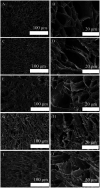Carbon nanotube reinforced polyvinyl alcohol/biphasic calcium phosphate scaffold for bone tissue engineering
- PMID: 35540653
- PMCID: PMC9075967
- DOI: 10.1039/c9ra08569f
Carbon nanotube reinforced polyvinyl alcohol/biphasic calcium phosphate scaffold for bone tissue engineering
Abstract
In this paper, a well-developed porous carbon nanotube (CNT) reinforced polyvinyl alcohol/biphasic calcium phosphate (PVA/BCP) scaffold was fabricated by a freeze-thawing and freeze-drying method. The microstructure, mechanical properties and the composition of the scaffolds were characterized by field emission scanning electron microscopy (FE-SEM), X-ray diffraction (XRD) and Fourier-transform infrared spectroscopy (FTIR). The results illustrate that after the incorporation of CNTs, the compressive strength of the hydrogels (moisture state) reached 81 ± 6 kPa, presenting a significantly higher value than that of pure PVA/BCP hydrogels (48 ± 2 kPa). Meanwhile, CNT reinforced PVA/BCP scaffolds exhibited a porous structure and high interconnectivity (80 ± 0.6%). The degradation analysis indicated that the degradation ratio of scaffolds can be varied by changing the concentrations of BCP powders and CNTs. Cell culture results show that PVA/BCP/CNT porous scaffolds have no negative effects on the survival and proliferation of cells. These results strongly show that the composite scaffolds may possess a potential application in the field of bone tissue engineering and regeneration.
This journal is © The Royal Society of Chemistry.
Conflict of interest statement
There are no conflicts to declare.
Figures















Similar articles
-
Physicochemical characterization and biocompatibility in vitro of biphasic calcium phosphate/polyvinyl alcohol scaffolds prepared by freeze-drying method for bone tissue engineering applications.Colloids Surf B Biointerfaces. 2012 Dec 1;100:169-76. doi: 10.1016/j.colsurfb.2012.04.046. Epub 2012 May 31. Colloids Surf B Biointerfaces. 2012. PMID: 22766294
-
Hydroxyethyl Chitosan-Reinforced Polyvinyl Alcohol/Biphasic Calcium Phosphate Hydrogels for Bone Regeneration.ACS Omega. 2020 May 6;5(19):10948-10957. doi: 10.1021/acsomega.0c00727. eCollection 2020 May 19. ACS Omega. 2020. PMID: 32455215 Free PMC article.
-
Processing and characterization of chitosan/PVA and methylcellulose porous scaffolds for tissue engineering.Mater Sci Eng C Mater Biol Appl. 2016 Apr 1;61:484-91. doi: 10.1016/j.msec.2015.12.084. Epub 2015 Dec 30. Mater Sci Eng C Mater Biol Appl. 2016. PMID: 26838875
-
Development of osteogenic chitosan/alginate scaffolds reinforced with silicocarnotite containing apatitic fibers.Biomed Mater. 2020 Aug 21;15(5):055020. doi: 10.1088/1748-605X/ab954f. Biomed Mater. 2020. PMID: 32438355
-
Fabrication and Characterization of Gelatin/Polyvinyl Alcohol Composite Scaffold.Polymers (Basel). 2022 Mar 30;14(7):1400. doi: 10.3390/polym14071400. Polymers (Basel). 2022. PMID: 35406273 Free PMC article.
Cited by
-
Synthesis of physically crosslinked PAM/CNT flakes nanocomposite hydrogel films via a destructive approach.RSC Adv. 2021 Dec 7;11(62):39095-39107. doi: 10.1039/d1ra07825a. eCollection 2021 Dec 6. RSC Adv. 2021. PMID: 35492498 Free PMC article.
-
Evaluation of Time-Dependent Corrosion Inhibition Rate for f-MWCNT-BCP Composite Coatings on 316L Stainless Steel in Simulated Body Fluid for Orthopedic Implantation.Appl Biochem Biotechnol. 2024 Mar;196(3):1544-1557. doi: 10.1007/s12010-023-04602-x. Epub 2023 Jul 11. Appl Biochem Biotechnol. 2024. PMID: 37432637
-
Nanostructured Polyacrylamide Hydrogels with Improved Mechanical Properties and Antimicrobial Behavior.Polymers (Basel). 2022 Jun 8;14(12):2320. doi: 10.3390/polym14122320. Polymers (Basel). 2022. PMID: 35745896 Free PMC article.
-
Effects of mechanical properties of carbon-based nanocomposites on scaffolds for tissue engineering applications: a comprehensive review.Nanoscale Adv. 2023 Dec 22;6(2):337-366. doi: 10.1039/d3na00554b. eCollection 2024 Jan 16. Nanoscale Adv. 2023. PMID: 38235087 Free PMC article. Review.
-
High-Strength Double-Network Conductive Hydrogels Based on Polyvinyl Alcohol and Polymerizable Deep Eutectic Solvent.Molecules. 2023 Jun 10;28(12):4690. doi: 10.3390/molecules28124690. Molecules. 2023. PMID: 37375245 Free PMC article.
References
LinkOut - more resources
Full Text Sources
Miscellaneous

